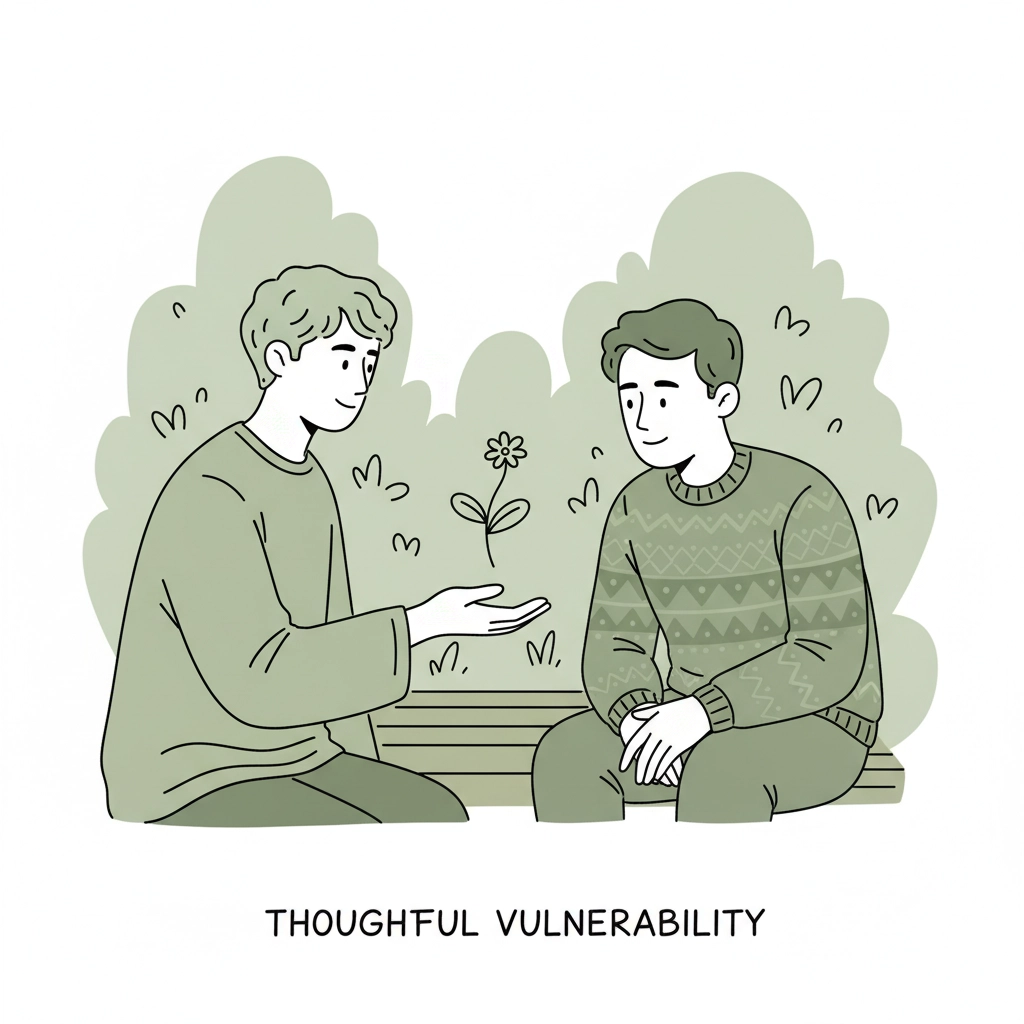SAVE 15% ON MM ROMANCE COLLECTIONS - Use code 15News at checkout on our romance collections for instant savings on high-angst male/male stories that master emotional intensity.
Understanding the Difference: Emotional Intensity vs. Trauma Dumping
Emotional intensity delivers controlled vulnerability through strategic character development. Authors craft meaningful revelations that build reader investment through careful pacing and authentic emotional progression between male protagonists.
Trauma dumping overwhelms with excessive backstory exposition, creating information overload rather than genuine connection. Characters become therapy sessions instead of romantic partners, exhausting readers rather than engaging them.

Why Readers Crave Deep Emotional Connection
Modern MM romance readers demand authentic emotional experiences. High-angst stories succeed when they:
- DELIVER EARNED EMOTIONAL PAYOFFS - Readers invest time expecting meaningful character growth
- CREATE REALISTIC MALE VULNERABILITY - Men processing trauma authentically resonates with target demographics
- BUILD TENSION THROUGH GRADUAL REVELATION - Controlled emotional intensity maintains reader engagement
- BALANCE PAIN WITH HEALING - Hope drives continued reading despite difficult content
BROWSE OUR LGBTQ+ COLLECTION for expertly crafted emotional intensity examples.
What Emotional Intensity Looks Like in Practice
EFFECTIVE EMOTIONAL INTENSITY INCLUDES:
Strategic Vulnerability Reveals
Characters share trauma in response to relationship development, not as exposition dumps. Male protagonists reveal pain through actions, dialogue, and internal conflict progression.
Balanced Power Dynamics
Both men contribute equally to emotional exchanges. Neither becomes therapist or patient exclusively.
Contextual Backstory Integration
Past trauma influences present behavior naturally rather than requiring extensive flashback sequences or information dumps.

Progressive Trust Building
Emotional sharing increases as romantic connection deepens, mirroring realistic relationship development patterns.
Red Flags: When Stories Cross Into Trauma Dumping
AVOID THESE COMMON MISTAKES:
Front-Loading Heavy Content
Opening chapters overwhelmed with abuse, addiction, or mental health crises without relationship context create reader fatigue.
One-Sided Emotional Labor
One character consistently provides support while the other only takes, creating imbalanced dynamics that frustrate readers.
Repetitive Trauma Processing
Characters rehashing identical pain points without growth or resolution bore audiences seeking character development.
Therapy Session Dialogue
Extended conversations focused solely on psychological analysis rather than romantic connection disconnect readers from the love story.
SHOP OUR GAY ROMANCE COLLECTION - Use code 15News for 15% savings on balanced emotional narratives.
Creating Genuine Emotional Resonance: Author Guidelines
Start With Character-Driven Motivation
ROOT TRAUMA IN CHARACTER GOALS - Past pain must serve character development and relationship conflict, not exist solely for emotional impact.
Use Show-Don't-Tell Techniques
DEMONSTRATE THROUGH BEHAVIOR - Characters reveal trauma through reactions, triggers, and coping mechanisms rather than exposition.

Balance Heavy Content With Relief
PROVIDE EMOTIONAL BREATHING ROOM - Include humor, tenderness, or relationship progress between intense emotional scenes.
Focus on Healing Through Connection
EMPHASIZE RELATIONSHIP GROWTH - Male protagonists heal together rather than fixing each other's problems.
Reader Preferences: What Creates Deeper Connection
SURVEY DATA INDICATES READERS PREFER:
- Gradual emotional revelation over immediate trauma dumps (78% preference)
- Balanced vulnerability between both male leads (82% preference)
- Realistic healing timelines rather than quick fixes (71% preference)
- Hope-driven narratives despite heavy content (89% preference)
SIGN UP FOR OUR NEWSLETTER - Get exclusive previews of new high-angst MM releases plus 15% discount code 15News for immediate use.
Current Market Trends in High-Angst MM Romance
Reader Fatigue With Excessive Trauma
Audiences increasingly reject books focused solely on suffering without character growth or relationship development.
Demand for Authentic Male Emotional Expression
Readers want realistic portrayals of men processing emotions rather than stoic stereotypes or therapy-speak dialogue.
Preference for Mutual Support Dynamics
Modern audiences favor relationships where both men contribute strength and vulnerability equally.

Interest in Diverse Trauma Representation
Beyond abuse narratives, readers seek stories addressing various emotional challenges: identity struggles, family rejection, career pressures, health issues.
Common Author Mistakes to Avoid
MISTAKE 1: CONFUSING INTENSITY WITH EXCESS More trauma doesn't equal deeper emotion. Strategic placement creates greater impact than constant crisis.
MISTAKE 2: NEGLECTING RELATIONSHIP BALANCE One character becoming emotional caretaker while the other remains project rather than partner.
MISTAKE 3: RUSHING EMOTIONAL RESOLUTION Realistic healing requires time and setbacks. Quick fixes disappoint readers seeking authentic character journeys.
MISTAKE 4: IGNORING READER EMOTIONAL CAPACITY Relentless heavy content without relief exhausts audiences, leading to abandoned reads and negative reviews.
Success Strategies for Authors
Plan Emotional Arcs Carefully
MAP CHARACTER DEVELOPMENT - Chart emotional revelation timing to support relationship progression and reader investment.
Research Trauma Responses Authentically
UNDERSTAND REALISTIC REACTIONS - Male trauma responses vary widely. Avoid stereotypes while maintaining accuracy.
Test Reader Emotional Capacity
BETA READER FEEDBACK - Monitor when content becomes overwhelming versus engaging through test audience responses.

Integrate Hope Throughout Narrative
BALANCE PAIN WITH PROGRESS - Even darkest moments should contain relationship advancement or character growth elements.
EXPLORE OUR IDENTITY AND SELF-EXPRESSION COLLECTION - Features expertly balanced emotional intensity in MM narratives.
Building Sustainable Reader Engagement
Successful high-angst MM romance creates emotional investment rather than emotional exhaustion. Readers return to authors who master intensity without overwhelming, creating loyal audiences for future releases.
KEY ENGAGEMENT FACTORS:
- Authentic male emotional expression
- Balanced relationship dynamics
- Strategic vulnerability reveals
- Hope-driven narrative progression
- Realistic healing timelines
Conclusion: Mastering Emotional Balance
Emotional intensity builds lasting reader connection through careful character development and relationship progression. Trauma dumping overwhelms audiences, creating negative reading experiences that damage author reputations.
Focus on authentic vulnerability, balanced dynamics, and hope-driven narratives to create MM romance that resonates deeply without exhausting readers.
VISIT AMAZON AUTHOR PAGE for curated high-angst MM romance recommendations that master emotional balance.
SHARE YOUR RECOMMENDATIONS - Comment with MM romance titles that achieved perfect emotional intensity without trauma dumping. Help fellow readers discover expertly crafted stories.
USE CODE 15News FOR 15% OFF - Apply at checkout on dickfergusonwriter.com for immediate savings on our complete MM romance library.
Follow us on social media:
- Instagram: https://www.instagram.com/dickfergusonwriter
- X/Twitter: https://www.x.com/DickFergus94902
- Facebook: https://www.facebook.com/profile.php?id=61572869844598
#MMRomance #HighAngstRomance #EmotionalIntensity #TraumaDumping #GayRomance #LGBTQ #MaleMaleRomance #RomanceWriting #BookRecommendations #EmotionalBalance


0 comments